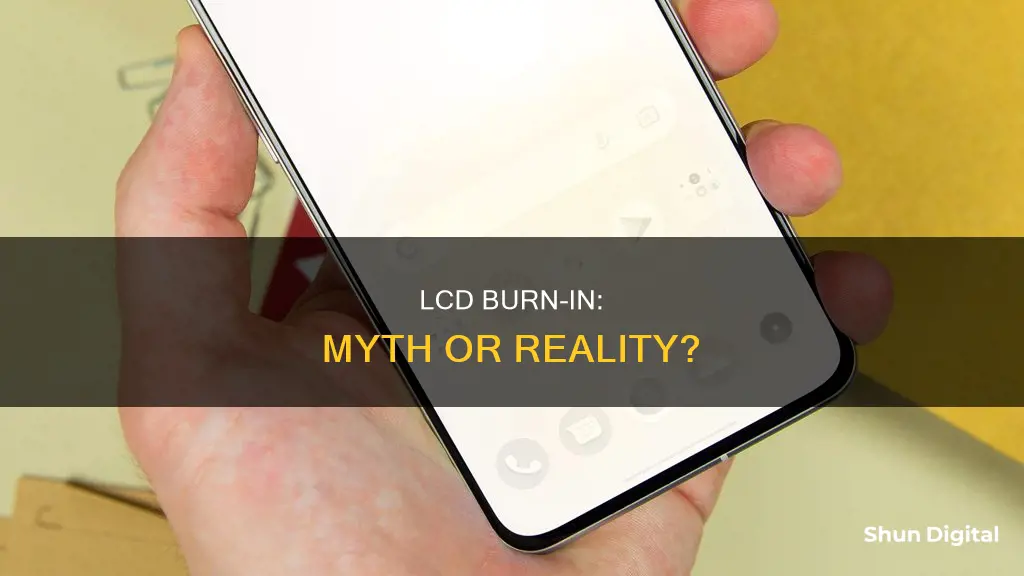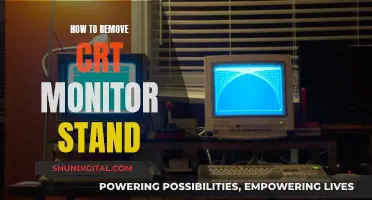
Unlike older cathode-ray tube (CRT) monitors, LCD monitors are not susceptible to screen burn-in, which is a permanent discoloration of areas on a display caused by cumulative non-uniform use of the screen. However, LCD monitors can suffer from a similar but non-permanent phenomenon called image persistence or image sticking, which occurs when pixels cannot return to their relaxed state after a static image is displayed for an extended period. Image persistence can be corrected and prevented by using screensavers, changing the background frequently, and setting the display to turn off after a few minutes of inactivity.
| Characteristics | Values |
|---|---|
| Susceptibility to burn-in | LCD screens are less susceptible to burn-in than plasma screens |
| Cause of burn-in | Cumulative non-uniform use of the screen |
| Burn-in prevention | Avoid displaying static images for more than two hours at a time; change the picture size or brightness periodically; use a screensaver |
| Burn-in correction | Use a rotating or white screen saver; turn off the display for a few hours |
| Image persistence | LCD screens are susceptible to image persistence, which is not permanent |
What You'll Learn

LCD monitors are not susceptible to burn-in like CRT monitors
Unlike CRT monitors, LCD monitors are not susceptible to burn-in. This is because LCD monitors use a different method to produce the image on the screen. While CRT monitors use phosphors to generate light and colour, LCD monitors use a white light behind the screen with polarizers and crystals to filter the light to specific colours.
Burn-in, or image burn-in, is a permanent discolouration of areas on an electronic visual display, such as a CRT monitor. It is caused by cumulative non-uniform use of the screen, such as the prolonged display of non-moving images, repetitive content in gaming graphics, or certain broadcasts with tickers and flags. This cumulative non-uniform use causes a breakdown in phosphors, which results in the image being burned into the screen.
While LCD monitors are not susceptible to burn-in in the same way, they can suffer from a similar phenomenon called image persistence or image retention. Image persistence is caused by the continuous display of static graphics on the screen for extended periods. When a different colour appears in the location of a static graphic, the colour will be off and will display a faint image of what was previously displayed. This is because the long-term static images prompt the LCD crystals to develop a memory for their location to generate the colours of that graphic.
Image persistence is not permanent and can be corrected in most cases. To prevent image persistence, it is recommended that users set their displays to turn off after a few minutes of inactivity or idle time, use a rotating screensaver, and change their backgrounds frequently.
Activity Monitor Data Usage: A 24-Hour Watch
You may want to see also

LCD monitors can suffer from image persistence
Unlike older monitors, LCD screens are not susceptible to screen burn-in. However, they can suffer from a similar phenomenon called image persistence or image sticking. This is when the continuous display of static graphics on the screen for extended periods causes the LCD crystals to develop a memory for their location to generate the colours of that graphic. When a different colour appears in that location, the colour will be off and will display a faint image of what was previously displayed.
Image persistence is caused by how the crystals in the display work. The crystals move from a position allowing all light through to one that doesn't allow any. When the screen displays an image for a long time, the crystals can switch to a particular position and may shift a bit to alter the colour, but not completely, resulting in a display other than the one intended.
The problem is most common for elements of the display that do not change, such as the taskbar, desktop icons, and background images. These tend to be static in their location and displayed on the screen for an extended period. Once other graphics load over these locations, it might be possible to see a faint outline or image of the previous graphic.
Image persistence on LCD screens can be corrected in most cases and easily prevented. Setting the screen to turn off after a few minutes of idle time can help prevent image persistence. Using a screensaver that rotates or has moving graphics can also help.
To correct image persistence, you can try turning off the monitor for an extended period, using a screen saver with a rotating image, or running the screen with a single solid colour or bright white for an extended time to force the crystals to reset.
Monitor Broadband Usage: A Guide for BSNL Users
You may want to see also

Image persistence is caused by the continuous display of static graphics
Unlike older monitors, LCD screens are not susceptible to burn-in in the same way. However, they can suffer from image persistence, which is caused by the continuous display of static graphics. This is because the crystals in LCD screens develop a memory for their location to generate the colours of a static graphic. When a different colour appears in that location, the colour will be off and will display a faint image of what was previously displayed.
Image persistence is not permanent and can be corrected. It is the result of how the crystals in the display work. The crystals move from a position allowing all light through to one that doesn't allow any. When the screen displays an image for a long time, the crystals can switch to a particular position. It may shift a bit to alter the colour, but not completely, resulting in a display other than the one intended.
The problem is most common for elements of the display that do not change, such as the taskbar, desktop icons, and background images. These tend to be static in their location and displayed on the screen for an extended period. Once other graphics load over these locations, it might be possible to see a faint outline or image of the previous graphic.
To prevent image persistence, it is recommended to set the screen to turn off after a few minutes of idle time. Using a screensaver that rotates or has moving graphics can also help. It is also a good idea to rotate any background images on the desktop and turn off the monitor when the system is not in use.
If image persistence does occur, it can be corrected by turning off the monitor for an extended period or using a rotating or white screensaver for an extended period to force the crystals to reset.
Enabling Audio on Your ASUS Monitor: A Simple Guide
You may want to see also

Image persistence can be corrected
Image persistence, or image retention, is a phenomenon in LCD and plasma displays where unwanted visual information is shown which corresponds to a previous state of the display. It is the modern flat-panel equivalent of screen burn-in, which was common in older CRT monitors.
Image persistence is caused by the continuous display of static graphics on the screen for extended periods. This prompts the LCD crystals to develop a memory for their location to generate the colours of that graphic. When a different colour appears in that location, the colour will be off and will display a faint image of what was previously displayed.
- Set the screen to turn off after a few minutes of idle time. Setting the monitor to turn off after 15 to 30 minutes of inactivity can make a difference.
- Use a screen saver with a rotating image or moving graphics, or a blank screen saver.
- Rotate any background images on the desktop. By switching backgrounds every day or every few days, you'll reduce the risk of persistence.
- Turn off the monitor when the system is not in use.
- Use a screen saver with a rotating colour palette for an extended period. This should remove the persistent image, but it may take some time.
- Run the screen with a single solid colour or bright white for an extended time to force the crystals to reset at a single colour setting.
In addition, "exercising" the LCD pixels to bleed off the residual capacitive charge can help remove "stuck" images. This can be done by using a random pattern screen saver that changes the screen image repeatedly. The time required to clear the stuck image can vary widely (from minutes to days) depending on the panel technology and the severity of the issue.
Unboxing Your ASUS Monitor: A Step-by-Step Guide
You may want to see also

Image persistence can be prevented
Image persistence, or image retention, is a phenomenon in LCD and plasma displays where unwanted visual information is shown which corresponds to a previous state of the display. It is the flat-panel equivalent of screen burn-in. The effects are usually temporary and often not visible without close inspection. However, image persistence can be prevented.
One way to prevent image persistence is to limit the display of any image in the same position for extended periods of time. This can be done by adjusting the display and screen settings in the operating system to turn off the screen after a short period of inactivity. For example, on a macOS device, this can be done in the Energy Saver section, and on Windows, this can be done in the Power Management section.
Another way to prevent image persistence is to use a screen saver that has moving graphics, rotates images, or is blank. A screen saver that changes the image on the screen frequently will reduce the risk of image persistence. Additionally, powering off the monitor when not in use will ensure that no image is displayed on the screen for extended periods of time.
Changing the desktop background images regularly is also recommended, as desktop backgrounds are a common source of image persistence. By switching them often, having the same image on the screen for too long can be avoided.
Finally, if you are using your LCD TV as a computer monitor, it is recommended to change the picture size for a minute or two every couple of hours. This can be done by reducing the brightness and contrast of the screen when it is displaying static elements, which will also decrease the chance of image persistence.
Understanding ASUS CPU Temp Monitoring: What's Really Going On?
You may want to see also
Frequently asked questions
Although LCD monitors are not susceptible to burn-in in the same way CRT monitors are, they can suffer from image persistence or image sticking, which is not permanent. This is caused by the continuous display of static graphics on the screen for extended periods.
To prevent burn-in, avoid keeping a static picture or a picture with static elements on your LCD monitor for more than two hours at a time. You should also change the image on your screen periodically and reduce the brightness and contrast of the screen when it is displaying static elements.
To fix burn-in on an LCD monitor, you can try using a rotating image screensaver or a white screensaver for an extended period to force the crystals to reset at a single-color setting.







